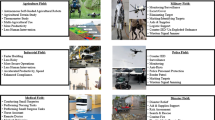Abstract
This article considers a methodological approach to recognize the intrusion of objects into a protected area using an optoelectronic robotic complex, which is based on the existence of a certain characteristic space (a set of signal and geometric features) for each class and type of object. The solved problem of comparing Bayesian a posteriori probabilities of classes (types) of objects is reduced to calculating a priori probabilities and energy distribution functions of signals and geometric parameters of objects, i.e., the likelihood functions of a feature for a specific class (type) of an object. Based on the obtained parameters, the dependences of the probability of correct recognition, omission, false recognition, and confusion of objects on the coefficient of distinctness when the object’s signal energy deviates from the standard energy are analyzed. The results obtained are required to solve the problem of the adaptive group control of robotic complexes when solving operational and tactical and tasks in an uncertain dynamic environment.
Similar content being viewed by others
REFERENCES
D. S. Chirov and S. P. Khripunov, “Intelligent methods for tactical situations recognition in the context of a-utonomous use of military robotic systems,” Vopr. Bezop., No. 1, 22–34 (2017). https://doi.org/10.7256/2409-7543.2017.1.21643
V. S. Simankov and E. V. Lutsenko, Adaptive Control of Complex Systems Based on the Theory of Pattern Recognition (Tekh. Univ. Kuban. Gos. Tekhnol. Univ., Krasnodar, 1999) [in Russian].
A. L. Gorelik and V. A. Skripkin, Recognition Methods (Vyssh. Shkola, Moscow, 1984) [in Russian].
A. S. Potapov, Pattern Recognition and Machine Perception (Politekhnika, St. Petersburg, 2007) [in Russian].
A. Faure, Perception et Reconnaissance des Formes (Editests, Paris, 1985); Russian transl.: Perception and Pattern Recognition (Mashinostroenie, Moscow, 1989).
V. N. Vasilev, I. P. Gurov, and A. S. Potapov, “Mathematical methods and algorithmic support for image analysis and recognition in information and telecommunication systems,” All-Russian competitive selection of analytical review articles on the priority research area “Information and Telecommunication Systems” (Moscow, 2008).
I. O. Sakovich and Yu. S. Belov, “Review of the contour analysis basic methods to distinguish moving object contours,” Inzh. Zh.: Nauka Innovatsii, No. 12, 1–8 (2014).
S. Yan, X. He, Y. Hu, H. Zhang, M. Li, and Q. Cheng, “Bayesian shape localization for face recognition using global and local textures,” IEEE Trans. Circuits Syst. Video Technol. 14 (1), 102–113 (2004). https://doi.org/10.1109/TCSVT.2003.818359
W. K. Pratt, Digital Image Processing (Wiley, New York, 1978; Mir, Moscow, 1982).
I. V. Razin and V. V. Teterin, “Mathematical model for a quick estimate of the degree of similarity of images,” J. Opt. Technol. 68 (11), 820–824 (2001). https://doi.org/10.1364/JOT.68.000820
D. G. Lowe, “Object recognition from local scale-invariant features,” in Proc. 7th IEEE Int. Conf. on Computer Vision (ICCV ’99) (Kerkyra, Greece, 20–27 September 1999), Vol. 2, pp. 1150–1157. https://doi.org/10.1109/ICCV.1999.790410
Q. Luo and T. M. Khoshgoftaar, “Unsupervised multiscale color image segmentation based on MDL principle,” IEEE Trans. Image Process. 15 (9), 2755–2761 (2006). https://doi.org/10.1109/TIP.2006.877342
L. R. Rabiner, “A tutorial on hidden Markov models and selected applications in speech recognition,” Proc. IEEE 77 (2), 257–285 (1989). https://doi.org/10.1109/5.18626
A. Glazunov, “Computer recognition of human faces,” Otkrytye Sist. SUBD, No. 3 (2000). https://www.osp.ru/os/2000/03/177945.
D. I. Samal and V. V. Starovoitov, Approaches and Methods for Recognizing People by Photo Portraits (ITK NANB, Minsk, 1998) [in Russian].
L. N. Chaban, Theory and Algorithms of Pattern Recognition: A Tutorial (Mosk. Gos. Univ. Geod. Kartogr., Moscow, 2004) [in Russian].
E. A. Patrick, Fundamentals of Pattern Recognition (Prentice-Hall, Englewood Cliffs, N. J., 1972; Sov. Radio, Moscow, 1980).
Yu. A. Pushkarev and E. Yu. Pushkareva, Automatic Control Systems in Rocket and Space Technology. Problems of Tracking and Terminal Control (Fil. VA RVSN im. Petra Velikogo, Serpukhov, 2020) [in Russian].
Yu. V. Prokhorov and Yu. A. Rozanov, Probability Theory. Basic Concepts. Limit Theorems. Stochastic Processes. Handbook, 3rd ed. (Nauka, Moscow, 1987) [in Russian].
V. V. Sviridov and Yu. A. Romanenko, “Methodical approach to the choice of means protection of a critical object,” Nadezhnost Kach. Slozhnykh Sist., No. 1 (25), 87–90 (2019). https://doi.org/10.21685/2307-4205-2019-2-10
V. V. Sviridov, G. T. Povshenko, and N. V. Fedoseenko, “Calculation of adaptive group control of military robotic complexes based on the flexibility of the control system structure to changing external conditions, with an assessment of combat effectiveness,” Certificate of State Registration of Computer Program No. 2020612894 (2020) [in Russian].
G. S. Kondratenkov, Earth Surveillance Radar Systems (Radio i Svyaz’, Moscow, 1988) [in Russian].
Computer and Selection Tasks, Ed by Yu.I. Zhuravlev (Nauka, Moscow, 1989) [in Russian].
Yu. S. Gulina and V. Ya. Kolyuchkin, “Methods for calculating the probabilities of image recognition by a human operator,” Vestn. MGTU im. N. E. Baumana, Ser. Priborostr., No. 1, 100–107 (2012).
S. V. Subbotin and D. Yu. Bolshakov, “Using a Bayesian classifier to recognize target classes,” Zh. Radioelektron., No. 4 (2006).
A. A. Tropchenko and A. Yu. Tropchenko, Methods of Secondary Processing and Image Recognition: A Tutorial (ITMO Univ., St. Petersburg, 2015) [in Russian].
B. M. Shchigolev, Mathematical Processing of Observations (Fizmatlit, Moscow, 1962) [in Russian].
Author information
Authors and Affiliations
Corresponding author
Ethics declarations
The authors declare that they have no conflicts of interest.
Rights and permissions
About this article
Cite this article
Pushkarev, Y.A., Sviridov, V.V. Object Recognition Method Based on Their Signal-Geometric Signs through a Robotic Security Complex. Math Models Comput Simul 15, 297–311 (2023). https://doi.org/10.1134/S207004822302014X
Received:
Revised:
Accepted:
Published:
Issue Date:
DOI: https://doi.org/10.1134/S207004822302014X




